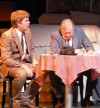In Death of a Salesman, Arthur Miller chose to stray from type, writing about a tragic male antihero held up by his steadfast, long-suffering wife. But seriously, the iconic Salesman is probably in my top five for most beautifully written theatre, and reading or hearing the words alone is enough to produce very willing tears from me. Unfortunately, much of SART’s current production seems to rely upon that notion, as it appears that much of the company hasn’t had either the time or the inclination (or both) to really delve into and embrace the words or the characters. Theirs is a production marked by some definite high points, but also by a lack somewhat in thoughtfulness and attention to detail.
At the risk of pedantry and in the interest of comprehensiveness, I suppose a brief rundown of the show is in order. Salesman hinges upon the character of Willie Loman (Michael Goodwin), an aging, traveling salesman “riding on a smile and a shoeshine,” whose career and life are both on a sharp decline, or perhaps have always been on a gradual one. His wife, Linda (Robin Arthur), ever by his side, attempts to shield him from his own misgivings about himself, and allows him to believe he is shielding her from his failures as the family’s breadwinner. Loman is frequently given to daydreams and delusions about his past and what he perceives to be missed opportunities, while he is haunted in the present by his dreams not coming to fruition for his grown sons, Biff (Chris Allison) and Happy (David Ostergaard).
I’ll give the bad news first. There were some odd aesthetic choices, most notably with the styling of Linda. Granted, grey hair is necessary due to mentions of it in the text; a wig very noticeably a wig in such a small space is less so, and actually had the effect of making her look too young in the role since her face doesn’t really match the given hair. I would not mention something so seemingly nitpicky but I truly found it distracting; my first visual impression was not of Linda, but of Linda’s wig. Also the set, by Richard Seagle, was a bit overly busy. It is no small task to create no fewer than six-plus spaces in one generally static set, but I would err on the side of simplicity in the actual dressings of the rooms; it was an awful lot to take in. Most of the costuming (Paula McWhirter-Buck) was done nicely and appropriately hearkened back to the play’s period, save an out-of-character nightie for Linda and an anachronistic T-shirt and sweatpants for Willie, as well as a strange choice to keep Linda in her apron when she joins the family for Biff’s football game. And, moving on to props, is it really so out-of-reach to find realistic-looking fake money? I realize that these all may seem like piddly trees in a bigger forest, but all of the missed points in combination added up to feel like the production was, in many ways, an afterthought.
As for the ensemble itself, very generally speaking, the play felt rather under-rehearsed. Blocking was at times arbitrary, and the minimal stage combat fairly slipshod, as though they hadn’t the time to practice it. Most actors seemed to be running over, through, or on top of the lines, often giving little more than lip service to some very powerful monologues, and sacrificing poignancy for pace. The two most outstanding exceptions to this observation are Allison as Biff, and, mercifully, Goodwin as Loman. Allison lends a quiet simmer of indignation with subtlety appropriate both to the size of the theatre and to the character, and his one-on-one exchanges with Goodwin in the second act are nothing short of heart-breaking. Goodwin enters the play much as expected, with the slow plod that was once a swagger, and his performance only improves as the play goes on. A tremendous range of emotion is demanded of any actor playing Loman, and Goodwin delivers time and time again. The labored father-son dynamic between the pair is as real as it gets, and I was regretting a dearth of tissues at several points.
Over all, I wish I had more of a sense that the company loved this show as much as I do, but I was grateful for the bursts of brilliance that came through, and as always grateful to relive some of my favorite turns of phrase from Miller.
Death of a Salesman, directed by William Gregg, runs at Mars Hill College’s Owen Theatre through Sunday, July 12. Shows Friday and Saturday at 7:30 p.m. with a Sunday matinee at 2:30 p.m.




Before you comment
The comments section is here to provide a platform for civil dialogue on the issues we face together as a local community. Xpress is committed to offering this platform for all voices, but when the tone of the discussion gets nasty or strays off topic, we believe many people choose not to participate. Xpress editors are determined to moderate comments to ensure a constructive interchange is maintained. All comments judged not to be in keeping with the spirit of civil discourse will be removed and repeat violators will be banned. See here for our terms of service. Thank you for being part of this effort to promote respectful discussion.